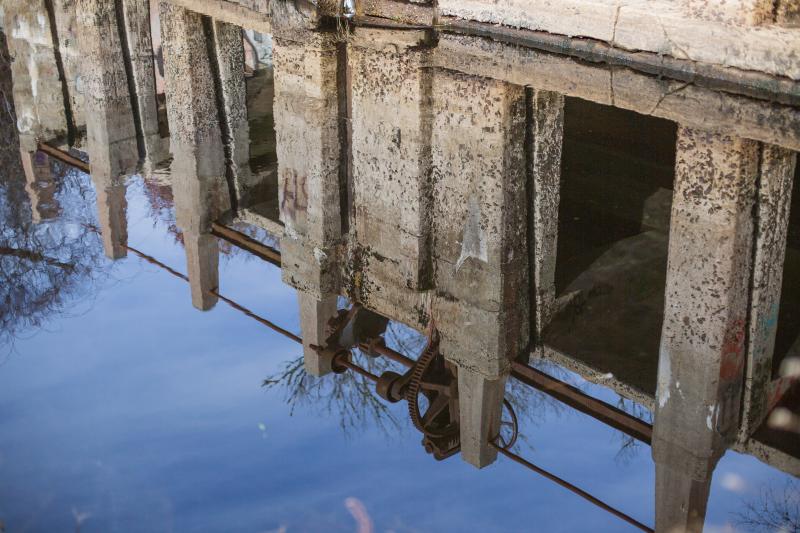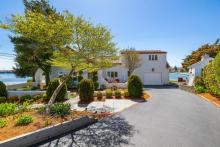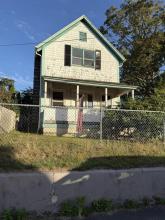Buzzards Bay Coalition announces plans to help restore Weweantic fish populations at Horseshoe Mill
The old Horseshoe Mill dam on the Weweantic River is a picturesque reminder of Wareham's pre-Revolutionary industrial past -- but it's a problem for the fish.
The Buzzards Bay Coalition, armed with a $45,000 grant to study options, is looking at removing or altering the dam on the land it has owned since 2012. On Tuesday, a coalition official explained those options and heard some suggestions from locals.
Sara N. da Silva Quintal said at the meeting the organization will publish the results of the feasibility study for several ideas the Coalition has to restore the area in the Spring of 2016.
Coalition Vice President Brendan Annett said at the meeting the organization purchased the land not only to preserve it for Wareham residents and visitors to enjoy, especially in the face of climate change, but specifically to create better environmental conditions that will allow the river’s many species of fish to grow again.
The old dam at the former mill site is located at the head of tide, the farthest point upriver where the river is affected by tidal fluctuations. At low tide, the water rushes through holes in the dam, creating temporary, small riffles that are conducive to marine life. But at high tide, Annett said in an earlier interview, the water rises.
“It floods up – it doesn’t start gushing [backwards] – but all this movement stops, because the water’s rising, so it’s not falling like that,” Annett said, gesturing to the water rushing through the dam at low tide. “The location of this dam at this spot, which is at the head of tide, is particularly problematic. … Dams … blocked rivers, and that meant that they blocked the movement of fish – fish that need to move, in order to reproduce.”
Annett said there are records of “hundreds of thousands” of fish that used to make runs upriver into Carver, where the Weweantic River begins. But those numbers have been declining. Among the many fish species that are declining in population, due to the difficulty of getting past the dam, is the rainbow smelt, Annett said; and it is about this species the Coalition is most concerned.
The population of rainbow smelt that travels towards the Horseshoe Mill is considered the southernmost viable population of smelt anywhere, Annett said – “anywhere south of here, their time has passed, unfortunately.”
“The rainbow smelt spawn right here,” Annett said of the head of tide area behind the dam. “They can’t go any further than this. … They spawn here at high tide, but then their eggs get left high and dry. It kills a lot of the eggs – an awful lot of the eggs.”
The other species affected by the dam’s placement are the American eel, white perch, and brook trout, the latter of which is not listed as endangered by the government, but “they are – there is only a handful of populations remaining, and they are declining.”
But all is not lost: thanks to restoration efforts at Red Brook, as well as the Coalition’s own restoration of The Sawmill in Acushnet, the fish populations in these areas have begun to bounce back. Annett said the Coalition used a stepped pool design for The Sawmill, which is ideal for herring.
“It went from a few hundred getting through to more than 10,000, just in the few years that we have had it,” Annett said.
But the river also faces the impact of climate change, such as the rise of water levels over time, due to global warming melting ice caps, Annett said. This destroys the salt marsh habitats that serve as nurseries for certain marine species, which are forced to move further inland upriver to maintain the same sort of habitat. Annett said the Coalition wants to “prepare the site to be more adaptable to climate change, so that, as we are losing salt marsh, and mudflats … there is no reason that, if this [dam] wasn’t here, things could slowly move up the river.”
The Coalition, Annett said, will be exploring several different designs for Horseshoe Mill, all of which take into consideration several factors about the fish populations they are trying to save, as well as the overall impact of climate change on the river. The organization presented the five different options to the public at a meeting Tuesday evening.
One design simply leaves the river and the dam as it is. The obvious issue there, Annett said at the meeting, is that fish continue to face population decline, and there are additional ecological issues associated with keeping the dam, such as the dam’s inevitable collapse. This would not only pose a safety hazard to visitors, but would also block up more of the waterway.
A second option would leave the dam there, but fix and maintain it, as well as add a fish ladder. This, Annett said, is feasible, but costly and inefficient, as there is no more industry in the area to warrant the dam. There is also no guarantee all the species of fish in the area would be able to make it up the ladder.
Another fish pathway the Coalition is examining is a stepped design, much like the structures at The Sawmill. The dam would be lowered somewhat, but would not be removed.
“The thing about that one is – it’s good for herring, but we need to see if it’s going to work [here], particularly with the smelt,” Annett said.
The fourth option is a sort of rocky slope, up which it would be easier for rainbow smelt to move. The dam would not be removed, but it would be lowered a bit to facilitate the fish’s movement. The final option is to take the dam away altogether. Though this would restore the natural movement of the river, a meeting attendee said he was concerned about the pond created on the other side of the dam, which holds several fish species more suited to calmer waters.
However, Selectman Judy Whiteside defended removing the dam, as “the only guys who should be damming the river are beavers.”
Annett also responded to Conservation Committee member Sandy Slavin’s concern that removing the dam would impact agricultural ventures that rely on the water in the area, saying there would be no water withdrawal from the removal of the dam.
Regardless of the design the Coalition chooses, all designs in which the dam is taken out will include walkways for the public, as the dam is currently used as a bridge to access the walking trails on the other side of the river. Annett also said the Coalition would preserve as many of the the historic elements at the site as possible, and include signage to tell the story of the river’s history.













